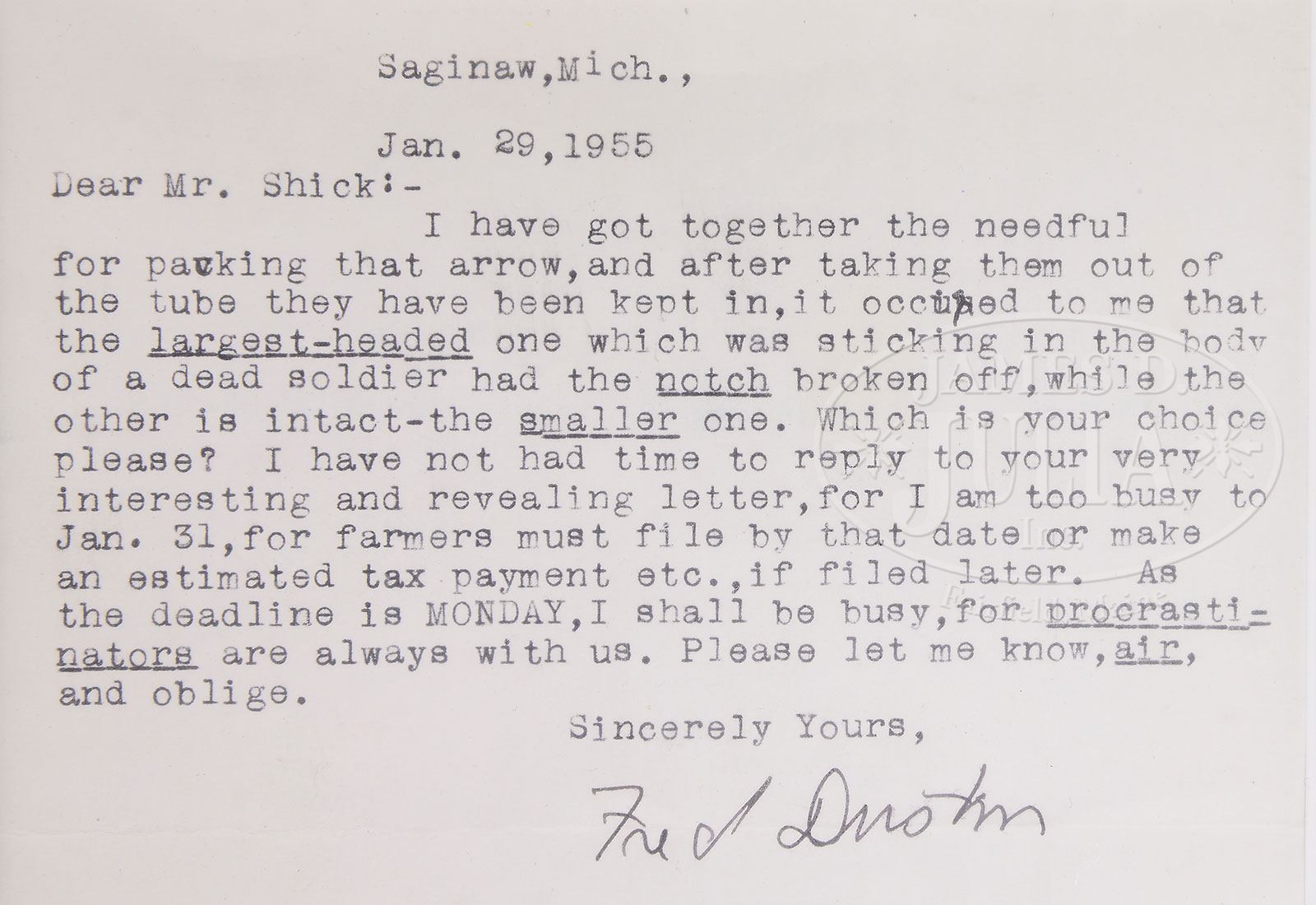| Image | Lot | Price | Description |
|
1435
|
$27,600.00
|
TWO EXTREMELY RARE INDIAN ARROWS FROM THE CUSTER BATTLEFIELD WITH GOOD PROVENANCE.These 2 arrows are illustrated in Fred Dustin’s book written in 1939 A Custer Tragedy on p. 194, fig. 4. Dustin corresponded with and interviewed a number of surviving Indians, civilian interpreters, and soldiers starting in the early 1900s for compilation of their personal narratives of the 1876 fight at Little Bighorn. He spent over 30 years researching the battle and its participants. Dustin was known for his disdain for Custer and criticism of his actions, and his support for the controversial Major Marcus Reno. Ironically, he made his only visit to the Custer Battlefield in 1938. The following year, he published his life’s research in a work entitled The Custer Tragedy: Events Leading Up to and Following the Little Big Horn Campaign in 1876, a work considered a classic in Custeriana. There is a series of correspondence between Fred Dustin and a collector in the 1950s elaborating the history dating back to John Gibbons who was the first to bury the dead on the battlefield. “…I have two steel-pointed arrows picked up on the field by a soldier who was there (whether of the 7th Cavalry or of Gibbon’s command, I do not know of have forgotten). One was sticking in the body of a dead soldier, the other lying on the ground. I offered them (Maj. Luce, Custer Battlefield collection) but never got a reply, so I think they will go to the Yale College collection”. This quote was from an April 20, 1954 letter from Dustin to Hugh Shick. This letter as they say, “got the ball rolling”. Several other letters pertain to these gifts finally given from Schick to Dustin. In a February 5, 1955 letter from Dustin to Schick “You ask-“How long can I keep it?” (the arrow). As long as you wish, but I hope you will pass it on to some worthy permanent institution, but NOT to Maj. Luce or his successor. The “Custer Battlefield Museum” is simply a George A. Custer collection-NOT a Custer Battlefield Museum at all…I am under the impression that the soldier who found the arrows was a member of Gibbon’s infantry…”Dustin was almost 90 years old when he wrote this letter and finally forwarded the arrows with a note dated September 3, 1956 just months before he died (the original candlebox used for shipping Schick had is also here. Interested parties should read the letters and correspondence from Dustin on website catalog. Fred Dustin’s papers are at the University of Michigan.” PROVENANCE: Fred Dustin, Hugh Shick 1956, Glen Swanson Collection, Don Nidiffer, Signature House Auction June 27, 2000, Lot 131. CONDITION: Arrows are as found and as described in letters. One missing an ear of its notch and only the base of the feathers still retaining sinew attaching them and sinew attaching tips. There are several twists of a more recent red thread holding sinew tight. These few wraps of red thread could be easily removed and were probably only added when framed. Shafts have great hand worn patina and small metal heads with iron patina with rust. The smaller of the 2 arrows measures 23-3/4″, the larger 24-1/4″. The arrows are framed between 2 pieces of plexiglass with the original tags from Dustin framed with them along with note from Hugh Shick written on back of photograph showing 1 arrow. 4-55013 JS105 (20,000-30,000) – Lot 1435 Click here to view provenance
Auction: Firearms - March 2015 Please Note: All prices include the hammer price plus the buyer’s premium, which is paid by the buyer as part of the purchase price. The prices noted here after the auction are considered unofficial and do not become official until after the 46th day. |


